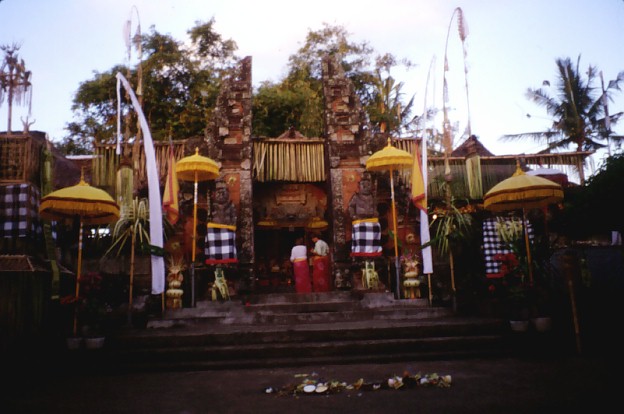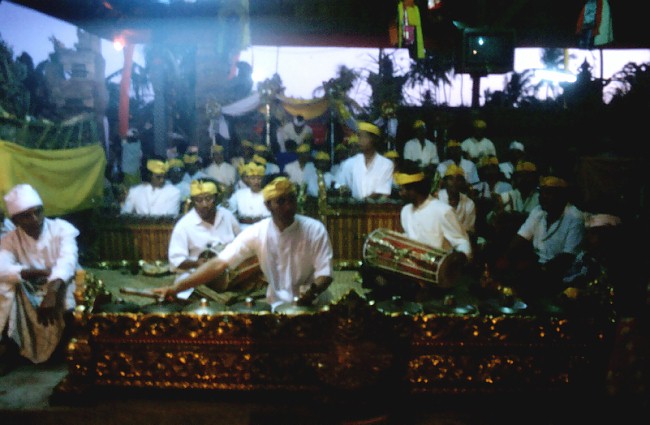Gamelan in the Night |
|||||||||||||||||||||||||||||||||||||||||||||||||||||||||||||||||||||||||||||||||||||||||||||||||||||||||||||||||||||||||||||||||||||||||||||||||||||||||||||||||||||||||||||||||||||||||||||||||||||||||||||||||||||||||||||||||||||||||||||||||||||||||||||||||||||||||||||||||||||||||||||||||||||||||||||||||||||||||||||||||||||||||||||||||||||||||||||||||||||||||||||||||||||||||||||||||||||||||||||||||||||||||||||||||||||||||||||||||||||||||||||||||||||||||||||||||||||||||||||||||||||||||||||||||||
|
|
The hours went by and evening drew on... |
||||||||||||||||||||||||||||||||||||||||||||||||||||||||||||||||||||||||||||||||||||||||||||||||||||||||||||||||||||||||||||||||||||||||||||||||||||||||||||||||||||||||||||||||||||||||||||||||||||||||||||||||||||||||||||||||||||||||||||||||||||||||||||||||||||||||||||||||||||||||||||||||||||||||||||||||||||||||||||||||||||||||||||||||||||||||||||||||||||||||||||||||||||||||||||||||||||||||||||||||||||||||
|
|
|
||||||||||||||||||||||||||||||||||||||||||||||||||||||||||||||||||||||||||||||||||||||||||||||||||||||||||||||||||||||||||||||||||||||||||||||||||||||||||||||||||||||||||||||||||||||||||||||||||||||||||||||||||||||||||||||||||||||||||||||||||||||||||||||||||||||||||||||||||||||||||||||||||||||||||||||||||||||||||||||||||||||||||||||||||||||||||||||||||||||||||||||||||||||||||||||||||||||||||||||||||||||||
|
|
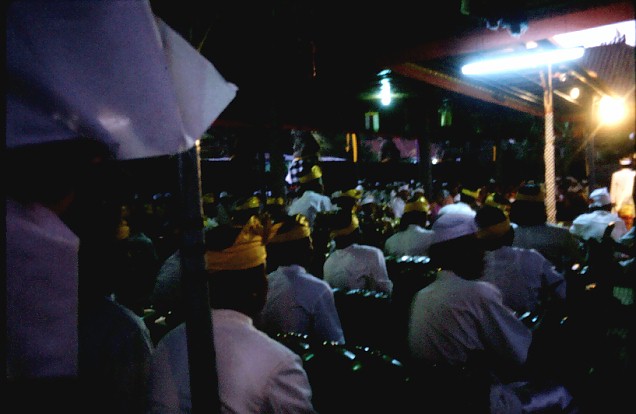 After the instruments and players had received their holy water, the gamelan began
playing. Incredible music, a wonderful sound coming from such a large and
evidently very important orchestra. Don't forget you can click on these
photos for a larger image.
After the instruments and players had received their holy water, the gamelan began
playing. Incredible music, a wonderful sound coming from such a large and
evidently very important orchestra. Don't forget you can click on these
photos for a larger image. |
||||||||||||||||||||||||||||||||||||||||||||||||||||||||||||||||||||||||||||||||||||||||||||||||||||||||||||||||||||||||||||||||||||||||||||||||||||||||||||||||||||||||||||||||||||||||||||||||||||||||||||||||||||||||||||||||||||||||||||||||||||||||||||||||||||||||||||||||||||||||||||||||||||||||||||||||||||||||||||||||||||||||||||||||||||||||||||||||||||||||||||||||||||||||||||||||||||||||||||||||||||||||
|
|
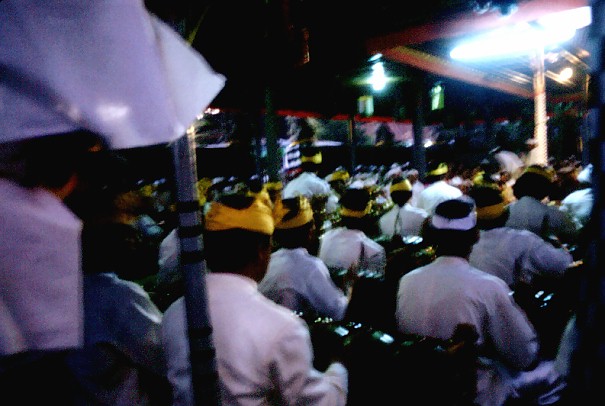 We felt incredibly privileged to be present at such an amazing event. As
gamelan players, it was a real thrill to see and hear such a great gamelan,
right up close.
We felt incredibly privileged to be present at such an amazing event. As
gamelan players, it was a real thrill to see and hear such a great gamelan,
right up close.
|
||||||||||||||||||||||||||||||||||||||||||||||||||||||||||||||||||||||||||||||||||||||||||||||||||||||||||||||||||||||||||||||||||||||||||||||||||||||||||||||||||||||||||||||||||||||||||||||||||||||||||||||||||||||||||||||||||||||||||||||||||||||||||||||||||||||||||||||||||||||||||||||||||||||||||||||||||||||||||||||||||||||||||||||||||||||||||||||||||||||||||||||||||||||||||||||||||||||||||||||||||||||||
|
The orchestra would play a few pieces and then stop and take a break. It was all very relaxed and informal. |
|||||||||||||||||||||||||||||||||||||||||||||||||||||||||||||||||||||||||||||||||||||||||||||||||||||||||||||||||||||||||||||||||||||||||||||||||||||||||||||||||||||||||||||||||||||||||||||||||||||||||||||||||||||||||||||||||||||||||||||||||||||||||||||||||||||||||||||||||||||||||||||||||||||||||||||||||||||||||||||||||||||||||||||||||||||||||||||||||||||||||||||||||||||||||||||||||||||||||||||||||||||||||
|
|
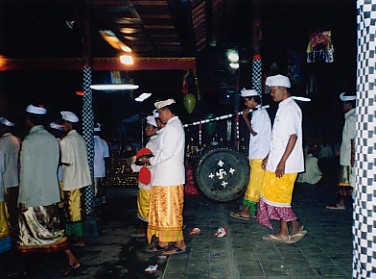 This is a beleganjur coming in from the dark and arriving into the
outer temple. The gong is decorated with the mystical Hindu-Buddhist swastika
and other magical symbols. You can see the people just ahead of the gong
playing the red-tassled ceng-cengs.
This is a beleganjur coming in from the dark and arriving into the
outer temple. The gong is decorated with the mystical Hindu-Buddhist swastika
and other magical symbols. You can see the people just ahead of the gong
playing the red-tassled ceng-cengs.
|
||||||||||||||||||||||||||||||||||||||||||||||||||||||||||||||||||||||||||||||||||||||||||||||||||||||||||||||||||||||||||||||||||||||||||||||||||||||||||||||||||||||||||||||||||||||||||||||||||||||||||||||||||||||||||||||||||||||||||||||||||||||||||||||||||||||||||||||||||||||||||||||||||||||||||||||||||||||||||||||||||||||||||||||||||||||||||||||||||||||||||||||||||||||||||||||||||||||||||||||||||||||||
|
|
|||||||||||||||||||||||||||||||||||||||||||||||||||||||||||||||||||||||||||||||||||||||||||||||||||||||||||||||||||||||||||||||||||||||||||||||||||||||||||||||||||||||||||||||||||||||||||||||||||||||||||||||||||||||||||||||||||||||||||||||||||||||||||||||||||||||||||||||||||||||||||||||||||||||||||||||||||||||||||||||||||||||||||||||||||||||||||||||||||||||||||||||||||||||||||||||||||||||||||||||||||||||||
|
|
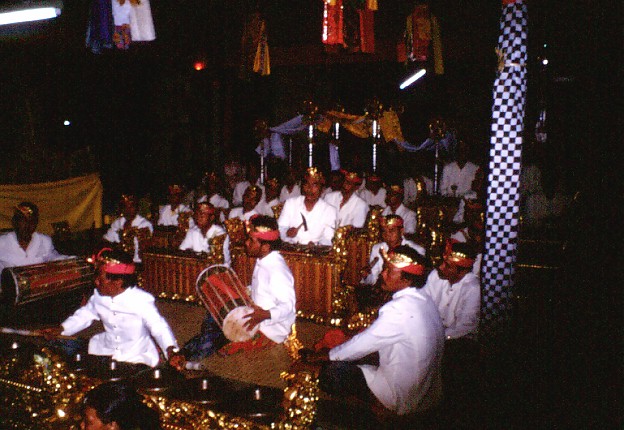 Once they were finished, the main gamelan struck up once again. The guys
next to the drummers are playing ceng-ceng - the sitting version
- a set of small finger cymbals which lend a crashing punctuation to the
piece, and often played by the drummer's apprentice. In this orchestra,
however, the two ceng-ceng players played a fabulous interlocked
section, in which they became featured instruments in their own right
- something we'd never seen before.
Once they were finished, the main gamelan struck up once again. The guys
next to the drummers are playing ceng-ceng - the sitting version
- a set of small finger cymbals which lend a crashing punctuation to the
piece, and often played by the drummer's apprentice. In this orchestra,
however, the two ceng-ceng players played a fabulous interlocked
section, in which they became featured instruments in their own right
- something we'd never seen before.
During the breaks, Pak Dibia told us some more about the Tall Barongs. Apparently the story goes that a man was involved in an adulterous relationship with another woman. The man's wife complained to the priest - a powerful practitioner of magic - who turned the man and his mistress into giants. The Tall Barongs, or Barong Landungs of this village are the images of the adulterous man and his mistress, forever doomed to wander the earth as giants. Also in this village is yet another extremely rare Barong - a Barong in the shape of a boar. If we were lucky we would see this one too... Another person we met at Singapadu was a French-Canadian guy, Pierre-Olivier,
from Montreal. He was interested in gamelan too, and was really
interested when he heard that we had a set of instruments and were taking
lessons from Pak Sedana. We decided to invite him to join our group
and play jegog. |
||||||||||||||||||||||||||||||||||||||||||||||||||||||||||||||||||||||||||||||||||||||||||||||||||||||||||||||||||||||||||||||||||||||||||||||||||||||||||||||||||||||||||||||||||||||||||||||||||||||||||||||||||||||||||||||||||||||||||||||||||||||||||||||||||||||||||||||||||||||||||||||||||||||||||||||||||||||||||||||||||||||||||||||||||||||||||||||||||||||||||||||||||||||||||||||||||||||||||||||||||||||||
|
|
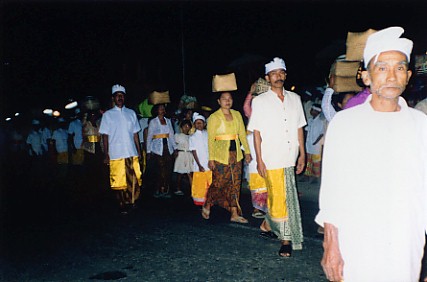 This is a procession of villagers passing by in the night. From the packed
up offerings on their heads it looks like they are on their way home from
another temple. It was a busy night that night, being a big festival day,
and we saw processions of people passing by, sometimes with their own marching
gamelans and Barongs.
This is a procession of villagers passing by in the night. From the packed
up offerings on their heads it looks like they are on their way home from
another temple. It was a busy night that night, being a big festival day,
and we saw processions of people passing by, sometimes with their own marching
gamelans and Barongs.
|
||||||||||||||||||||||||||||||||||||||||||||||||||||||||||||||||||||||||||||||||||||||||||||||||||||||||||||||||||||||||||||||||||||||||||||||||||||||||||||||||||||||||||||||||||||||||||||||||||||||||||||||||||||||||||||||||||||||||||||||||||||||||||||||||||||||||||||||||||||||||||||||||||||||||||||||||||||||||||||||||||||||||||||||||||||||||||||||||||||||||||||||||||||||||||||||||||||||||||||||||||||||||
 While the gamelan orchestra took a break, the kids of the village would
come up and play around on the instruments. It was quite ok for them to
do this - nobody minded. Children in Bali are treated quite wonderfully,
and seem to be a part of even the most sacred ceremonies. It's perfectly
natural to have children running around in the temple - it's all part
of life. The children are actually considered to be recently returned
from Heaven and just beginning a new incarnation on Earth, so are treated
with special respect. If you look closely you can see the palm-leaf offerings
tied onto the ends of the instruments for Tumpuk Landep - click on the
picture for a closer look.
While the gamelan orchestra took a break, the kids of the village would
come up and play around on the instruments. It was quite ok for them to
do this - nobody minded. Children in Bali are treated quite wonderfully,
and seem to be a part of even the most sacred ceremonies. It's perfectly
natural to have children running around in the temple - it's all part
of life. The children are actually considered to be recently returned
from Heaven and just beginning a new incarnation on Earth, so are treated
with special respect. If you look closely you can see the palm-leaf offerings
tied onto the ends of the instruments for Tumpuk Landep - click on the
picture for a closer look.
|
|||||||||||||||||||||||||||||||||||||||||||||||||||||||||||||||||||||||||||||||||||||||||||||||||||||||||||||||||||||||||||||||||||||||||||||||||||||||||||||||||||||||||||||||||||||||||||||||||||||||||||||||||||||||||||||||||||||||||||||||||||||||||||||||||||||||||||||||||||||||||||||||||||||||||||||||||||||||||||||||||||||||||||||||||||||||||||||||||||||||||||||||||||||||||||||||||||||||||||||||||||||||||
|
|
|
||||||||||||||||||||||||||||||||||||||||||||||||||||||||||||||||||||||||||||||||||||||||||||||||||||||||||||||||||||||||||||||||||||||||||||||||||||||||||||||||||||||||||||||||||||||||||||||||||||||||||||||||||||||||||||||||||||||||||||||||||||||||||||||||||||||||||||||||||||||||||||||||||||||||||||||||||||||||||||||||||||||||||||||||||||||||||||||||||||||||||||||||||||||||||||||||||||||||||||||||||||||||
